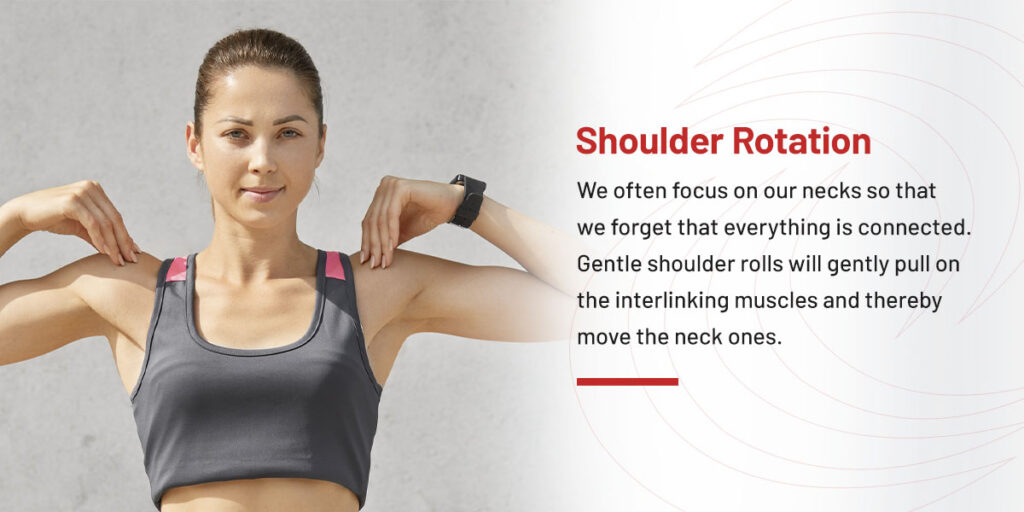
The term “whiplash” comes from the whip-like motion that occurs during this condition. The head is suddenly jerked backward and then forward, causing the structures in the neck to be stretched beyond their normal range of motion. It sounds like an impossible movement, but it is actually very common in car accidents and sports. Every year, more than 2 million people in the U.S. experience it.
If you recently experienced whiplash, you may be wondering how you got it, how it affects you, and what exercises you can do to restore your body. We cover all of those questions in this article.
Whiplash is a common neck injury that usually happens with car accidents or any type of sudden, forceful movement of the neck. The movement causes a hyperextension, which is a backward thrust and a hyperflexion, which is the forward thrush. This motion causes:
Whiplash primarily impacts the cervical spine, which can be jolted or displaced. The vertebrae most infected are from C1 to C7. This area is usually highly mobile and allows the head to move in all types of directions, but it is also vulnerable to injury if jolted.
The abrupt motion causes injury on the:
Soft tissues, such as the muscles, tendons and ligaments, are the components most affected. They are stretched and torn during the process, leading to inflammation and swelling. The swelling further pressurizes the other bones and components, causing further pain and discomfort.
The symptoms of whiplash can vary widely in both type and duration. The most common include:
In severe cases, the symptoms might extend to:
Most patients with whiplash recover eventually. But there are those who experience issues in the longer term, such as:
Before conducting any type of exercise for whiplash, ensure you have a chat with your healthcare professional. They will physically examine your neck and ask you to do some movement to see your range of motion. If they are concerned, they will ask for imaging tests to be done to confirm there are no fractures or unknown damages. Once you are in the clear, ask them about exercises you can do. Here are some whiplash stretches that you can run past them as possibilities:
Chin tucks gently stretch the muscles in the cervical spine. Get comfortable by sitting in a chair and putting your head in a neutral position with your eyes forward. Take a breath in and as you exhale, gently release the muscles of the neck and slowly move your chin toward the chest. Your eyes will naturally lower, and you will end up looking at your knees. Hold for a few seconds. On the next inhale, slowly lift your head back into a neutral position with your eyes looking straight ahead.
You can repeat this 10 times, in your own time and comfort. If you feel any pain or discomfort, immediately stop and maybe try again tomorrow.
A good place to start for neck exercises for whiplash are rotations. Neck rotation helps to stretch and strengthen the muscles in the neck. You start the process by sitting comfortably in a chair, legs unfolded, feet on the floor. Relax your shoulders and leave your neck in a neutral position. Gentle turn your head, keeping your chin level with the floor. Let your eyes move with the head. Stop when you feel a slight stretch. Hold for a few seconds. On your next exhale, move your head back into a neutral position, keeping the head level. Repeat on the other side.

We often focus on our necks so that we forget that everything is connected. Gentle shoulder rolls will gently pull on the interlinking muscles and thereby move the neck ones. Either stand or sit comfortably and take a few breaths to just relax the muscles. As you exhale, pull your shoulders forward, then roll them up and back. As you inhale, feel the shoulder blades pull towards your spin, then gently pull down and back into neutral. Do this in a gentle, flowing movement. When your shoulders are back, try and hold a few seconds before finishing the roll. Repeat a few times.
This exercise targets the neck and the upper back all in one. Start in a comfortable sitting position and gently place your palms on your forehead. Push your head against your palm without bending your neck. Hold it there for about five seconds. Take a breath and then place the hands on the back of your head and repeat the same movement. After about five seconds, release your hands and take a breath.
We have done the head, shoulders, neck and upper back, but now let’s focus on the middle back, where your trapezius muscle is. Gently pull your head diagonally forward, aiming to touch your chin to your armpit. Hold for 15 to 30 seconds when you feel a gentle pull. Release and move your head back into a neutral position. Take a breath and then repeat with the other hand.
Every whiplash patient situation is different. Chat with a professional from DISC for a tailor-made exercise and rehabilitation plan for your whiplash. We have vast experience in whiplash and all spine conditions. By reaching out and starting the process early, you can minimize the risk of long-term symptoms.
Your neck deserves the best care available, and that’s precisely what we are all about. For a consultation with one of our spine specialists or to learn more about your treatment options, contact us online.